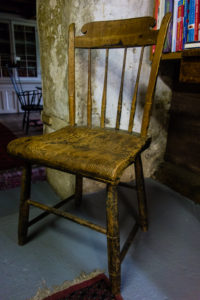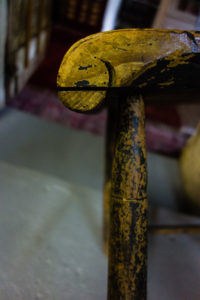Pitch Forks
by Elia Bizzarri | Feb 16, 2019 | 3 Comments
Curtis Buchanan called last week. We talked of our class schedules, springpole lathes (we are both building one) and the book Curtis is reading Craeft: An Inquiry into the Origins and True Meaning of Traditional Crafts. Curtis is persuasive; I have bought the book and am now on the third chapter about haymaking. read more…
Traditional Wheelbarrow with Peter Ross & Elia Bizzarri
by Elia Bizzarri | Feb 1, 2019 | 2 Comments
Peter Ross and I have been wanting to teach together for years, but what to teach? Peter’s a blacksmith, but my chairs don’t need any metal bits. A couple months ago we realized that a wheelbarrow would be perfect; it can be partially made with green wood, it has plenty of metal parts for Peter to teach and everyone needs a nice wheelbarrow to show off to the neighbors. I know I do.
I can’t wait to spend a week with Peter – he’s one of the best. Here’s the info:
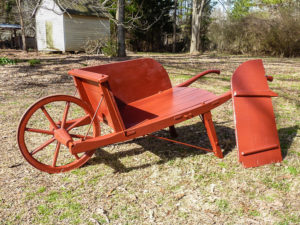 Learn traditional woodworking and blacksmithing techniques as you build a handsome wheelbarrow. Elia will help you split a log, shave the parts, split tenons with a chisel, then use dry draw-bored pins to lock the green joints together. You’ll bandsaw and chisel a wheel from dry oak boards and attach it’s metal rim. As you forge brackets and braces for your wheelbarrow, you’ll learn basic blacksmithing techniques from one of the best blacksmiths in the country. read more…
Learn traditional woodworking and blacksmithing techniques as you build a handsome wheelbarrow. Elia will help you split a log, shave the parts, split tenons with a chisel, then use dry draw-bored pins to lock the green joints together. You’ll bandsaw and chisel a wheel from dry oak boards and attach it’s metal rim. As you forge brackets and braces for your wheelbarrow, you’ll learn basic blacksmithing techniques from one of the best blacksmiths in the country. read more…
No-Glue Stools
by Elia Bizzarri | Jan 20, 2019 | 0 Comments
I’ve talked about this “good-no-good” joint a couple times before. Basically you turn it green, dry it for a couple days in a kiln and drive it into a green mortise. I first saw this joint in Jennie Alexander’s collection of old busted chair parts on an 18th C. post and rung chair and I’ve since seen similar joints on the ends of 18th C. Windsor spindles, which I assume means the seat was green at the time of assembly. If the joint ever loosens, it acts like a ball-and-socket joint; lots of wiggle but it can’t ever come apart, hence Jennie’s “good-no-good” moniker.
I’ll be teaching how to make a stool using this joint at Penland and probably during my Greenwood Week, so I’ve been practicing a lot.
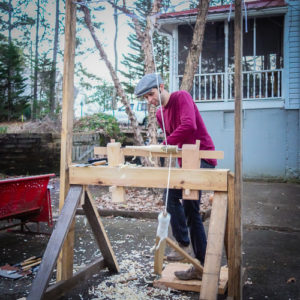
Turn the parts on the lathe.
Jane Mickelborough Spoon Carving Class
by Elia Bizzarri | Jan 15, 2019 | 0 Comments

I’m excited to announce my first-ever guest instructor! Jane Mickelborough will teach a small spoon carving class in my shop while she’s in the states visiting Curtis Buchanan. She’s taught at Spoon Fest and hosts a spoon-carving festival in France where she lives; I’m excited to meet her and learn from her.
I still have a few spots open in my chairmaking classes, including a Continuous Arm class in March. Plus, Peter Ross and I are ironing out the details for a 19th Century wheelbarrow class where the students will make a wooden wheelbarrow and all it’s iron hardware. Stay tuned! read more…
Soup-to-Nuts Chair Class
by Elia Bizzarri | Dec 21, 2018 | 0 Comments
Seth (resident toolmaker, rivings splitter, cook and nice guy) suggested I run a two week class, from log to paint. Since my new Greeenwood Week is filling up, I figured I might as well try this too. I’ve been building a spring-pole lathe and intend to park it in my girlfrind’s backyard while I re-learn how to use it. My first lathe was a spring-pole lathe (or really a bungee lathe), back when I was a teenager. I’m excited to have an excuse to use one again!
Here’s the pitch:
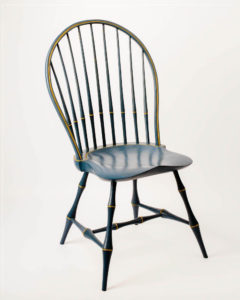 Log to paint: make a chair from start to finish, including the turnings! Want to build a chair entirely with handtools, no exceptions, no short-cuts? Or would you rather use a few power-tools to ease your day? The choice is yours in this two-week Loop Back Windsor class. read more…
Log to paint: make a chair from start to finish, including the turnings! Want to build a chair entirely with handtools, no exceptions, no short-cuts? Or would you rather use a few power-tools to ease your day? The choice is yours in this two-week Loop Back Windsor class. read more…
Birch Bark Canoe
by Elia Bizzarri | Dec 11, 2018 | 2 Comments
César’s Bark Canoe, Bernard Gosselin, provided by the National Film Board of Canada
A follower of this blog sent me the link to this video about a Native American making a canoe with a dozen tools and four materials: birch bark he strips from a large birch tree, cedar splints he rives with a knife, spruce roots he ties like string and gum he works like epoxy. Yet despite his rustic materials, the canoe he makes is a thing of grace and beauty.
A fascinating and humbling film.
Old Guy’s Mistakes
by Elia Bizzarri | Nov 20, 2018 | 0 Comments
My girlfriend and I went up to Brandywine, PA over July 4th to visit friends. One day we walked to a 19th C. three story milk barn that had been converted to an enormous used book store. I spent more time looking at chairs than I did books – they had over a dozen early 19th. C. Windsors. Always something to learn.
Going through my photos today, I found a few interesting ones:
New class: Greenwood Week
by Elia Bizzarri | Nov 2, 2018 | 0 Comments
I’ve been wanting to try this class for a while now and this year I finally decided to take the plunge. Roy Underhill used to teach a class like this at his school and I always enjoyed the day when I’d go and ‘help’, which mostly involved watching students work and eating Roy’s lunches. When Roy stopped teaching the class, he suggested I could do something similar at my place. I never have, until now. I’m excited!
Here’s the info:
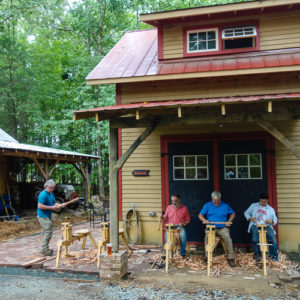 Spend a week working wood as nature intended. We’ll walk in the woods and learn about how to choose a tree. We’ll fell the tree with an ax and learn about splitting and riving it. A variety of projects will teach us how to exploit wood’s strengths and weaknesses for our benefit. Emphasis will be placed on learning fundamentals that can be applied to a variety of projects, green or dry. read more…
Spend a week working wood as nature intended. We’ll walk in the woods and learn about how to choose a tree. We’ll fell the tree with an ax and learn about splitting and riving it. A variety of projects will teach us how to exploit wood’s strengths and weaknesses for our benefit. Emphasis will be placed on learning fundamentals that can be applied to a variety of projects, green or dry. read more…
Chair Stories: The Sheriff and the Trailer
by Elia Bizzarri | Oct 28, 2018 | 2 Comments
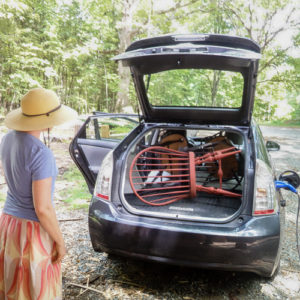
Last week my sweetheart Morgan delivered the last four loop backs in a set of six loop backs and two sack backs. Who knew four chairs would fit in a Prius! Here’s the story I wrote about the chairs:
I was off recently to buy a white oak log for a set of loop back chairs, but as I hooked up my trailer I noticed it had a flat tire. Darn! As I wrestled to get the rusted lug nuts off, I remembered my first trailer…
I was twenty-two years old, dirt poor and cocksure. The cheapest trailer I could find was a tobacco trailer, which I quickly bought for a hundred dollars.
New tires were soon needed, costing more than the trailer itself. The next week I went to the log yard to get a huge hickory log. I heard some knocking noises as I headed home, but finding nothing wrong I kept driving. Four lug nuts on my trailer continued to slowly loosen. read more…
The Chairmaker and the Boys
by Elia Bizzarri | Oct 5, 2018 | 4 Comments
The Chairmaker and the Boys, , provided by the National Film Board of Canada
Since my last post I found this fictional video from 1959 of a couple boys playing at Ernest Hart’s mill and chair shop. The shop seems to have been cleaned out somewhat for the film, compared to the film in my last post.
Ernest has a massive line-shaft driven patternmaker’s lathe. At 5:00 we see him turning Birch chair legs. By the curls you can tell the wood is green. Why did roughing gouges seem to all have curved tips back then?
read more…
Subscribe to Elia's Blog
Recent Posts
Search the Blog
Donations
Donate below to help keep the blog going. Thanks!
Categories
- Chair Stories (32)
- Chairmaking Tools and Supplies (42)
- Chairs For Sale (5)
- Classes (58)
- Craft Films (44)
- How-To (41)
- Antique Chairs (8)
- Drill Bits (3)
- Spoon Bits (3)
- Finishing (9)
- No-Glue joints (3)
- Rakes and Hay Forks (1)
- Samuel Wing Book Project (10)
- Sprinpole Lathe (2)

